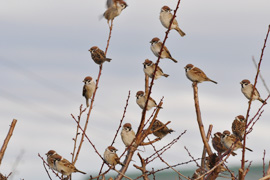The Mitsui & Co. Environment Fund
Introduction to Grant Projects
Faculty of Science, Department of Life Science, Rikkyo University Professor Keisuke Ueda
Elucidation of factors behind decline in sparrow populations, proposal relating to the coexistence of man and familiar animals
Research grant
- Project Description
It is said that sparrow populations are declining. The sparrow is our most familiar bird, welcomed by many people in their daily lives. Should populations continue to decline, the sparrow too could conceivably face a danger of extinction, following on the path of such once common creatures as medakas and cybisters. Furthermore, a population diminishment on the part of some nearby and familiar species hints at some change in our everyday environment as well. For these two reasons, we are compelled to promptly determine the factors behind this decline. Here, to obtain an accurate understanding of the situation at hand (i.e., just what is happening where), we comprehensively surveyed sparrow observational data obtained throughout Japan by entities ranging from private individuals to government agencies. Armed with this information, we next extracted presumably relevant factors. Field studies, including mark-recapture surveys and DNA analyses, not only revealed considerably more about sparrow ecology than previously known, but also provided an opportunity to discern if the factors extracted above are indeed relevant to these population declines. We conclude with a proposal for how to address declines in populations of familiar/nearby organisms.
- Fields
- Preservation of biodiversity and ecosystem
- Grant year
- FY2009 Research Grants
- Grant term
- 3 years
April 2010 - March 2013
- Grant amount
- 34,620,000 yen
- Activity region
- Japan

Overview of the Organization

- Representative
- Professor Keisuke Ueda
- Profile
- Specialist field
Ornithology/behavioral ecology
Affiliated academic societies
The Ornithological Society of Japan; Japan Ethological Society (Chairman, 2007-2010); Biological Science (Tokyo) (Rural Culture Association Japan, pub.), Chief Editor; Science Council of Japan, member (2006-2008), American Ornithologists' Union; America Society of Naturalists; British Ornithologists' Union; International Ornithological Committee (committee member)
Background
Became a Doctor of Science in 1985 at the Faculty of Agriculture, Osaka Prefecture University. From 1986-1989 was a Part-time Lecturer (biology) at the Faculty of Education, Mie University. In 1989 took the position of Associate Professor at the General Education Section, Department of Natural Science, Rikkyo University. In 1996 took a position of Associate Professor (biological science), Department of Chemistry, College of Science, Rikkyo University. Became a Professor at the Department of Life Science, Rikkyo University in 2001. - Collaborating researchers
- Osamu MIKAMI, Assistant Professor, Iwate Medical University; Gen MORIMOTO, Researcher, Rikkyo University
- Research record
-
- (1) Ueda, K. & Narui, Y. (2004) A new breeding tactic of the common moorhen: interspecific brood parasitism of bittern nests. Ornithol. Sci. 3:163-166.
- (2) Tanaka, K. D. & Ueda, K. (2005) Horsfield's hawkcuckoo nestlings simulate multiple gapes for begging. Science 308: 653
- (3) Sato, N. J., Tokue, K., Noske, R. A., Mikami, O. K., Ueda, K. (2010) Evicting cuckoo nestlings from the nest: a new anti-parasitism behaviour. Biology Letters 6: 67-69.
- (4) Ueda, K., Ippu issai no shinwa: Tori no kekkon shakaigaku (Aoki Shobo), 1987, 258pp.
- (5) Ueda K., Tori ha naze atsumaru? – mure no kodo seitaigaku (Tokyo Kagaku Dojin), 1989, 201pp.
- (6) Ueda, K., ♂♀ no hanashi – tori (Gihodo Shuppan), 1993, 230pp.
- (7) Ueda, K. Hana, tori, mushi no shigarami shinkaron – "Kyoshinka" wo kangaeru (Tsukiji Shokan Publishing), 1995, 270pp.
- (8) Ueda, K., commentator, Yacho 282 (Shogakukan Inc.), 1997, 320pp.